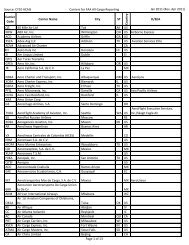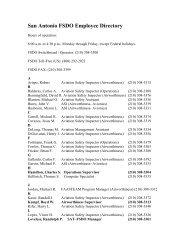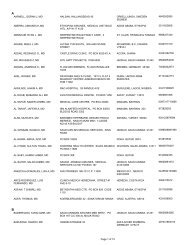- Page 1 and 2:
U.S. Department of Transportation F
- Page 3 and 4:
NOTICES TO AIRMEN September 22, 201
- Page 5 and 6:
Notices to Airmen Table of Contents
- Page 7 and 8:
Notices to Airmen Table of Contents
- Page 9 and 10:
Subscription Information vii SUBSCR
- Page 11 and 12:
Notices to Airmen Foreword PART 2.
- Page 13 and 14:
Notices to Airmen NOTAM CONTRACTION
- Page 15 and 16:
Notices to Airmen Contraction Decod
- Page 17 and 18:
Notices to Airmen Contraction Decod
- Page 19 and 20:
Notices to Airmen NS Nimbostratus N
- Page 21:
Notices to Airmen Contraction Decod
- Page 25 and 26:
Notices to Airmen FDC NOTAMs ANCHOR
- Page 27:
Notices to Airmen FDC NOTAMs SEATTL
- Page 30 and 31:
Section 2 Content Criteria All publ
- Page 32 and 33:
FDC NOTAMs FDC 0/6254 11A FI/T CLAY
- Page 34 and 35:
FDC NOTAMs FDC 1/3429 ADK FI/T IAP
- Page 36 and 37:
FDC NOTAMs FDC 1/6083 PPC FI/T SPEC
- Page 38 and 39:
FDC NOTAMs FDC 1/5583 PHX FI/T IAP
- Page 40 and 41:
FDC NOTAMs FDC 1/6551 M18 FI/T HOPE
- Page 42 and 43:
FDC NOTAMs FDC 0/7309 HHR FI/T JACK
- Page 44 and 45:
FDC NOTAMs FDC 0/8589 LAX FI/T LOS
- Page 46 and 47:
FDC NOTAMs Oxnard FDC 1/7846 OXR FI
- Page 48 and 49:
FDC NOTAMs FDC 0/1801 SAN FI/T SAN
- Page 50 and 51:
FDC NOTAMs FDC 1/0553 COS FI/P IAP
- Page 52 and 53:
FDC NOTAMs FDC 1/2985 GXY FI/T GREE
- Page 54 and 55:
FDC NOTAMs FDC 1/2940 HFD FI/T SID
- Page 56 and 57:
FDC NOTAMs FDC 1/0576 DCA FI/T IAP
- Page 58 and 59:
FDC NOTAMs FDC 1/3431 RSW FI/T SOUT
- Page 60 and 61:
FDC NOTAMs FDC 1/3008 MIA FI/T SID
- Page 62 and 63:
FDC NOTAMs St Petersburg−Clearwat
- Page 64 and 65:
FDC NOTAMs FDC 1/8148 FTY FI/T FULT
- Page 66 and 67:
FDC NOTAMs FDC 7/2863 SSI FI/T MALC
- Page 68 and 69:
FDC NOTAMs FDC 0/8607 ITO FI/T HILO
- Page 70 and 71:
FDC NOTAMs FDC 1/7161 BLV FI/P IAP
- Page 72 and 73:
FDC NOTAMs FDC 9/0236 MLI FI/T QUAD
- Page 74 and 75:
FDC NOTAMs FDC 1/1056 SPI FI/P IAP
- Page 76 and 77:
FDC NOTAMs FDC 1/5913 MGC FI/P CHAR
- Page 78 and 79:
FDC NOTAMs Pocahontas Muni FDC 1/49
- Page 80 and 81:
FDC NOTAMs FDC 1/5594 CVG FI/T CINC
- Page 82 and 83:
FDC NOTAMs FDC 1/3919 BTR FI/T ODP
- Page 84 and 85:
FDC NOTAMs FDC 1/6520 PWM FI/T PORT
- Page 86 and 87:
FDC NOTAMs Clearview Airpark FDC 0/
- Page 88 and 89:
FDC NOTAMs FDC 1/2543 BTL FI/T W K
- Page 90 and 91:
FDC NOTAMs FDC 1/5327 AZO FI/T IAP
- Page 92 and 93:
FDC NOTAMs Albert Lea Muni FDC 1/87
- Page 94 and 95:
FDC NOTAMs FDC 1/6526 GTR FI/T GOLD
- Page 96 and 97:
FDC NOTAMs FDC 1/3791 4K3 FI/T ODP
- Page 98 and 99:
FDC NOTAMs FDC 1/0430 MLS FI/T FRAN
- Page 100 and 101:
FDC NOTAMs FDC 1/2602 LAS FI/T SID
- Page 102 and 103:
FDC NOTAMs FDC 0/8864 LEB FI/T LEBA
- Page 104 and 105:
FDC NOTAMs FDC 0/2797 N40 FI/T SKY
- Page 106 and 107:
FDC NOTAMs FDC 0/3468 MAL FI/T MALO
- Page 108 and 109:
FDC NOTAMs FDC 1/5905 N66 FI/T ONEO
- Page 110 and 111:
FDC NOTAMs FDC 1/5673 GWW FI/T IAP
- Page 112 and 113:
FDC NOTAMs FDC 0/8146 SOP FI/T MOOR
- Page 114 and 115:
FDC NOTAMs FDC 1/5486 ISN FI/T IAP
- Page 116 and 117:
FDC NOTAMs FDC 1/9282 TDZ FI/T ODP
- Page 118 and 119:
FDC NOTAMs FDC 1/5622 LKV FI/T LAKE
- Page 120 and 121:
FDC NOTAMs FDC 0/0504 N94 FI/T CARL
- Page 122 and 123:
FDC NOTAMs FDC 1/2812 PJC FI/T IAP
- Page 124 and 125:
FDC NOTAMs FDC 1/5846 PVD FI/T THEO
- Page 126 and 127:
FDC NOTAMs FDC 0/1714 6J2 FI/T ST G
- Page 128 and 129:
FDC NOTAMs Nashville Intl FDC 1/270
- Page 130 and 131:
FDC NOTAMs FDC 0/1847 AUS FI/T AUST
- Page 132 and 133:
FDC NOTAMs FDC 1/3060 RBD FI/T SID
- Page 134 and 135:
FDC NOTAMs FDC 1/2037 DFW FI/T DALL
- Page 136 and 137:
FDC NOTAMs FDC 1/3020 AFW FI/T SID
- Page 138 and 139:
FDC NOTAMs FDC 8/8636 F12 FI/T RUSK
- Page 140 and 141:
FDC NOTAMs FDC 0/8605 IWS FI/T WEST
- Page 142 and 143:
FDC NOTAMs FDC 1/9855 MAF FI/T ODP
- Page 144 and 145:
FDC NOTAMs FDC 1/1897 ARM FI/T IAP
- Page 146 and 147:
FDC NOTAMs FDC 1/6044 BTV FI/T IAP
- Page 148 and 149:
FDC NOTAMs FDC 0/7358 LVL FI/T LAWR
- Page 150 and 151:
FDC NOTAMs WILLIAMSBURG Williamsbur
- Page 152 and 153:
FDC NOTAMs FDC 1/5523 CRW FI/T IAP
- Page 154 and 155:
FDC NOTAMs FDC 1/6447 UNU FI/T IAP
- Page 156 and 157:
FDC NOTAMs FDC 1/3260 ETB FI/T WEST
- Page 159:
Part 1. FDC NOTAMs Section 3. Gener
- Page 162 and 163:
FDC NOTAMs AIRMAN CERTIFICATE ISSUE
- Page 164 and 165:
FDC NOTAMs KGS), ARE NOT AUTHORIZED
- Page 166 and 167:
FDC NOTAMs Notices to Airmen SPECIA
- Page 168 and 169:
FDC NOTAMs Notices to Airmen FDC 0/
- Page 170 and 171:
FDC NOTAMs THROUGHOUT THE NATIONAL
- Page 172 and 173:
FDC NOTAMs Notices to Airmen MAKING
- Page 175:
Part 2. REVISIONS TO MINIMUM ENROUT
- Page 178 and 179:
Part 95 Revisions Notices to Airmen
- Page 180 and 181:
Part 95 Revisions Notices to Airmen
- Page 182 and 183: Part 95 Revisions Notices to Airmen
- Page 185: Part 3 INTERNATIONAL NOTICES TO AIR
- Page 189 and 190: Notices to Airmen International SEC
- Page 191 and 192: Notices to Airmen International KEN
- Page 193 and 194: Notices to Airmen International to
- Page 195 and 196: Notices to Airmen International 1.
- Page 197: Notices to Airmen International SUD
- Page 200 and 201: International 3−INTL−16 GENERAL
- Page 202 and 203: International 3−INTL−18 WEATHER
- Page 204 and 205: International 3−INTL−20 Notices
- Page 206 and 207: International 3−INTL−22 Notices
- Page 208 and 209: International 3−INTL−24 Notices
- Page 210 and 211: International 3−INTL−26 Notices
- Page 212 and 213: International 3−INTL−28 Notices
- Page 214 and 215: International 3−INTL−30 Notices
- Page 216 and 217: International San Juan Center: Jose
- Page 218 and 219: International SIGNIFICANT POINT 3
- Page 220 and 221: International 3−INTL−36 Notices
- Page 222 and 223: International 3−INTL−38 Notices
- Page 224 and 225: International 3−INTL−40 Notices
- Page 226 and 227: International 3−INTL−42 NEW YOR
- Page 228 and 229: International 3−INTL−44 Notices
- Page 230 and 231: International 3−INTL−46 (1) “
- Page 234 and 235: International to lat. 18�14’00
- Page 236 and 237: International 3−INTL−52 Notices
- Page 238 and 239: International 3−INTL−54 Notices
- Page 240 and 241: International 3−INTL−56 Notices
- Page 242 and 243: International 3−INTL−58 Notices
- Page 244 and 245: International 10. Contacts. ATC que
- Page 246 and 247: International 3−INTL−62 POSITIO
- Page 248 and 249: International 3−INTL−64 Notices
- Page 250 and 251: International 3−INTL−66 Notices
- Page 252 and 253: International 3−INTL−68 Notices
- Page 254 and 255: International 3−INTL−70 GULF OF
- Page 256 and 257: International 3−INTL−72 Notices
- Page 258 and 259: International 3−INTL−74 Notices
- Page 260 and 261: International 3−INTL−76 Notices
- Page 262 and 263: International 3−INTL−78 Notices
- Page 264 and 265: International 3−INTL−80 Notices
- Page 267: Section 1. General
- Page 270 and 271: Discontinuance of 121.5 & 243 MHz f
- Page 272 and 273: Precision Object Free Zone Precisio
- Page 274 and 275: Area Navigation Flight Plan Filing
- Page 276 and 277: Operation on U.S. Area Navigation R
- Page 278 and 279: Notices to Airmen RNAV Off−the−
- Page 280 and 281: Publication of ATC Altitude Restric
- Page 282 and 283:
Reduced Vertical Separation Minimum
- Page 285:
Section 2. Military
- Page 288 and 289:
Military Helicopter Operations 4−
- Page 290 and 291:
Military Helicopter Operations Noti
- Page 292 and 293:
Special Use Airspace, Temporary Mil
- Page 294 and 295:
Special Use Airspace, Temporary Mil
- Page 296 and 297:
Special Use Airspace, Temproary Mil
- Page 298 and 299:
Modification of Special Use Airspac
- Page 300 and 301:
Modification of Special Use Airspac
- Page 302 and 303:
Final Approach Runway Occupancy Sig
- Page 304 and 305:
Final Approach Runway Occupancy Sig
- Page 306 and 307:
Final Approach Runway Occupancy Sig
- Page 308 and 309:
Notices to Airmen Special Use Airpa
- Page 313 and 314:
Notices to Airmen Philadelphia Inte
- Page 315 and 316:
Notices to Airmen PENNSYLVANIA Spec
- Page 317 and 318:
Notices To Airmen Intersecting Runw
- Page 319 and 320:
Notices to Airmen JFK Runway/Taxiwa
- Page 321 and 322:
Notices to Airmen KBOS Land and Hol
- Page 323 and 324:
Notices to Airmen Oper. Eval. of RW
- Page 325 and 326:
Notices to Airmen Oper. Eval. of RW
- Page 327 and 328:
Notices to Airmen Oper. Eval. of RW
- Page 329 and 330:
Notices to Airmen Oper. Eval. of RW
- Page 331 and 332:
Notices to Airmen Philadelphia Inte
- Page 333 and 334:
Notices to Airmen Philadelphia Inte
- Page 335:
Notices to Airmen Groton−New Lond
- Page 340 and 341:
Special High Altitude Q Routes Noti
- Page 342 and 343:
Atlanta Hartsfield−Jackson Intl A
- Page 344 and 345:
Atlanta Visual Separation Notices t
- Page 346 and 347:
FLL Runway Closure and Delay Inform
- Page 348 and 349:
Orlando International Airport Runwa
- Page 350 and 351:
Orlando International Airport Runwa
- Page 352 and 353:
Orlando International Airport Runwa
- Page 354 and 355:
Atlanta TRACON/ Atlanta ARTCC/ Augu
- Page 356 and 357:
13° 26° ATL Reduced Divergence Ar
- Page 361 and 362:
Notices to Airmen OHIO Cleveland−
- Page 363 and 364:
Notices to Airmen Cleveland (CLE AT
- Page 365 and 366:
Notices to Airmen DTW Standard (Cod
- Page 367:
Notices to Airmen Chicago O’Hare
- Page 372 and 373:
DFW International Airport Runway St
- Page 374 and 375:
DFW International Airport Runway St
- Page 376 and 377:
DFW International Airport Runway St
- Page 378 and 379:
DFW International Airport Runway St
- Page 380 and 381:
DFW International Airport Runway St
- Page 382 and 383:
DFW Visual Separation Procedures 4
- Page 384 and 385:
DFW/DAL Visual Separation Procedure
- Page 389 and 390:
Notices to Airmen Lambert−St. Lou
- Page 391:
Northwest United States NORTHWEST
- Page 394 and 395:
Special Use of Visual Separation Pr
- Page 396 and 397:
Special Use of Visual Separation Pr
- Page 398 and 399:
Seattle Approach Control (S46) Conc
- Page 400:
Seattle Approach Control (S46) Conc
- Page 404 and 405:
San Francisco SOIA/PRM Notices to A
- Page 406 and 407:
LGB Airport FAROS Evaluation Notice
- Page 408 and 409:
Runway Status Lights at San Diego I
- Page 410 and 411:
Runway Status Lights at San Diego I
- Page 412 and 413:
Los Angeles International Airport R
- Page 414 and 415:
Los Angeles International Airport R
- Page 416 and 417:
Los Angeles International Airport R
- Page 418 and 419:
Denver Standard Taxi Routes Notices
- Page 420 and 421:
LAX Noise Abatement Procedures Noti
- Page 422:
Visual Separation for Aircraft Tran
- Page 426 and 427:
Lake Hood Seaplane Base Notices to
- Page 428 and 429:
IFR RNAV Operations Using GPS Notic
- Page 430 and 431:
Increased Surveillance for ADS−B
- Page 432 and 433:
Line Up and Wait Operations Notices
- Page 435:
Section 4. Major Sporting and Enter
- Page 438 and 439:
Sylvania 300 NASCAR Sprint Cup Seri
- Page 440 and 441:
Sylvania 300 NASCAR Sprint Cup Seri
- Page 442 and 443:
Sylvania 300 NASCAR Sprint Cup Seri
- Page 444 and 445:
Sylvania 300 NASCAR Sprint Cup Seri
- Page 446 and 447:
Sylvania 300 NASCAR Sprint Cup Seri
- Page 448 and 449:
Sylvania 300 NASCAR Sprint Cup Seri
- Page 450 and 451:
Sunbelt Agricultural Exposition Not
- Page 452 and 453:
Kansas Speedway Hollywood Casino 40
- Page 454 and 455:
Kansas Speedway Hollywood Casino 40
- Page 456 and 457:
NSCS AAA 500 Special Air Traffic Pr
- Page 458 and 459:
National Business Aviation Associat
- Page 460 and 461:
National Business Aviation Associat
- Page 462 and 463:
National Business Aviation Associat
- Page 464 and 465:
University of Alabama Football 4−
- Page 466 and 467:
University of Alabama Football 4−
- Page 468 and 469:
Talladega 500 4−SPORT−34 FREQUE
- Page 470 and 471:
Talladega 500 TYPE ACFT ROUTE ALTIT
- Page 472 and 473:
Talladega 500 Aircraft departing AS
- Page 474 and 475:
Talladega 500 4−SPORT−40 Direct
- Page 476 and 477:
Dover AAA 400 Sprint Cup NASCAR Eve
- Page 478 and 479:
Dover AAA 400 Sprint Cup NASCAR Eve
- Page 480 and 481:
Dover AAA 400 Sprint Cup NASCAR Eve
- Page 482 and 483:
Dover AAA 400 Sprint Cup NASCAR Eve
- Page 484 and 485:
Notre Dame Football Season 2011 4
- Page 486 and 487:
Notices to Airmen NORTH CAROLINA NA
- Page 488 and 489:
Notices to Airmen NORTH CAROLINA IF
- Page 491:
Section 5. Airshows
- Page 494 and 495:
AOPA Summit 2011 4−AIR−4 AIRCRA
- Page 496 and 497:
AOPA Summit 2011 4−AIR−6 Notice
- Page 498 and 499:
AOPA Summit 2011 Notices to Airmen
- Page 500 and 501:
AOPA Summit 2011 Notices to Airmen
- Page 502 and 503:
AOPA Summit 2011 4−AIR−12 Notic
- Page 504 and 505:
2011 Copperstate Fly−In Notices t
- Page 506 and 507:
2011 Copperstate Fly−In Notices t
- Page 508 and 509:
2011 Copperstate Fly−In Notices t
- Page 510 and 511:
2011 Copperstate Fly−In Notices t
- Page 512 and 513:
2011 Copperstate Fly−In Notices t
- Page 515 and 516:
JANUARY − 2012 FEBRUARY − 2012





